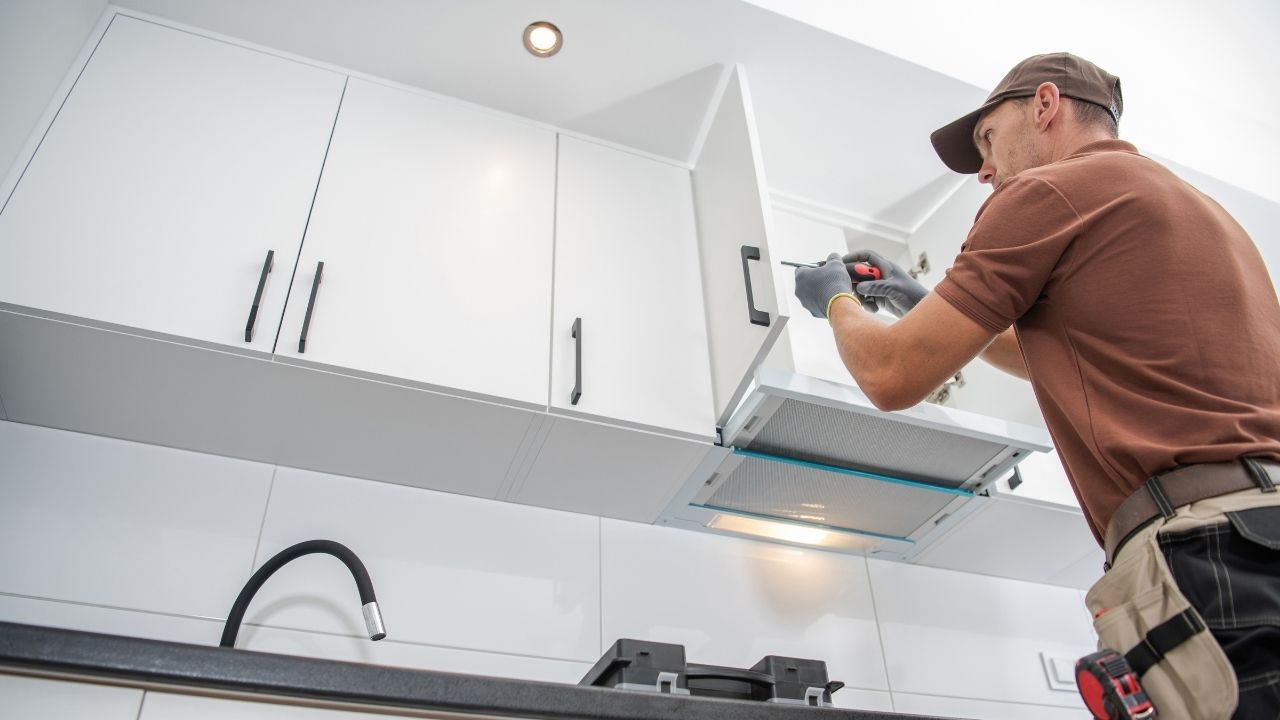Selecting the right cabinets transforms your kitchen both aesthetically and functionally. From minimalist condos to luxury estates, homeowners weigh style, durability, and cost when considering cabinetry. One of the most crucial decisions involves the choice of material, because what’s behind the doors matters just as much as the design on the front. Whether you’re planning a whole house remodel or focusing solely on the kitchen or living room, cabinetry sets the tone for both style and structure, making it a foundational design choice.
In this guide, we’ll break down kitchen cabinet materials into 25 distinct types, covering a range of prices and styles. Whether you’re planning a complete kitchen renovation or updating a rental unit, this comprehensive overview helps you align your goals with the appropriate materials.
1. Solid Wood: Natural Beauty with Classic Strength
Solid wood cabinets offer timeless appeal and long-term durability—species such as maple, oak, cherry, and hickory offer unique grain patterns and warm tones. While expensive, they handle wear well and can be refinished multiple times. They’re ideal for traditional, rustic, or upscale kitchens that prioritize natural aesthetics and longevity.
2. Plywood: Engineered for Structural Integrity
Plywood consists of layered wood veneers bonded with strong adhesives, creating a sturdy core. It resists warping and holds fasteners better than particleboard. Frequently used as cabinet boxes beneath premium finishes, plywood strikes a balance between affordability and durability. It’s often preferred in high-use kitchens seeking structure without the solid wood price.
3. MDF: Smooth Finish, Ideal for Paint
Medium-density fiberboard is formed by combining fine wood fibers with resin to create a smooth, dense surface. It’s highly stable, resisting cracks and expansion. Often painted or used under laminate, MDF is a versatile and affordable material. However, it’s vulnerable to water damage and not suitable for areas with consistent humidity or exposure to moisture.
4. Particleboard: Economical but Fragile Core
Made from wood chips, sawdust, and adhesive, particleboard is a cost-saving core material. Used in budget cabinetry, it’s covered with laminate or melamine for durability. It’s lightweight but susceptible to swelling and sagging when exposed to moisture. Best for low-traffic or temporary kitchen setups where budget is the priority.
5. Melamine: Low-Cost, Easy-Care Surface
Melamine is a plastic coating thermally fused onto particleboard or MDF, providing a rigid, wipeable surface. It’s available in various colors and textures. Though affordable and straightforward to clean, it may chip at corners and isn’t heat-resistant. Suitable for modern, budget-friendly kitchens with modest usage demands and simple designs.
6. Thermofoil: Glossy Coating with Style Versatility
Thermofoil is a thin vinyl layer heat-sealed onto MDF cabinet doors. It offers a seamless, smooth finish in gloss or matte. Often used in contemporary kitchens, it mimics the appearance of painted wood without visible brush marks. However, proximity to heat sources may cause the paint to peel over time. Ideal for minimal upkeep and clean lines.
7. Stainless Steel: Industrial Durability with Sleek Style
Stainless steel cabinets resist moisture, heat, and bacteria, making them popular in commercial kitchens. They add a contemporary, high-end aesthetic and last for decades. While durable, they show smudges easily and may appear cold in residential designs. Perfect for modern kitchens prioritizing hygiene, resilience, and a metallic aesthetic.
8. Aluminum: Lightweight and Rust-Resistant Option
Aluminum cabinets deliver a clean, modern appearance and resist corrosion. Lighter than steel, they’re often paired with glass panels for a futuristic design. While not prone to rust, they dent easily and amplify noise. Great for sleek, urban kitchens but require padding or liners to reduce metallic sounds and vibrations.
9. Laminate: High-Pressure Layers for Daily Wear
High-pressure laminate sandwiches layers of resin, paper, and decorative film under extreme heat. It’s scratch-resistant, easy to maintain, and available in a diverse range of styles—from wood-grain to solid colors. Durable and budget-friendly, laminate cabinets are well-suited for busy households. Edges can delaminate over time, but repairs are generally affordable and can be completed quickly.
10. Acrylic: Bold Shine for High-End Finishes
Acrylic offers a high-gloss, mirror-like finish with vibrant color options. Typically applied to MDF cores, acrylic surfaces are scratch-resistant and reflective, adding depth and brightness to kitchens. It’s more expensive than laminates and reveals fingerprints effortlessly—acrylic suits luxury modern kitchens where aesthetics and brightness take center stage.
11. Bamboo: Eco-Friendly and Structurally Tough
Bamboo is a fast-growing grass with a hardwood-like feel. It’s sustainable, durable, and visually distinct with a linear grain. Often used in modern or eco-conscious homes, bamboo cabinets resist warping and provide excellent strength. They require proper sealing but offer a natural, environmentally responsible alternative to traditional woods.
12. Veneer: Authentic Look on a Budget
Wood veneer involves thin slices of real wood adhered to a stable core, such as MDF or plywood. It mimics the appearance of solid wood without the cost. Veneers must be sealed to prevent moisture intrusion, but they offer great flexibility in terms of finish and color. Ideal for stylish kitchens on a mid-range budget.
13. PVC: Moisture-Resistant and Maintenance-Free
PVC cabinets are made from polyvinyl chloride sheets attached to MDF or particleboard. They’re waterproof, termite-resistant, and easy to clean, making them popular in humid climates. While affordable, they lack color variety and may discolor when exposed to UV light. Excellent for utility or rental kitchens requiring minimal maintenance and longevity.
14. Glass: Elegant Transparency with Functional Appeal
Glass-front cabinets enhance depth, reflect light, and offer display space. Options include frosted, textured, or clear glass. Though elegant, glass requires frequent cleaning and careful handling. Often used in upper cabinets, glass pairs well with wood or metal frames to create visual contrast in transitional and contemporary kitchens.
15. Reclaimed Wood: Character-Driven and Sustainable
Reclaimed wood comes from salvaged barns, factories, or antique furniture, offering a rich patina and a unique history. It’s eco-friendly and full of character, showing aged knots, textures, and imperfections. Perfect for rustic or industrial kitchens, it requires sealing to prevent moisture issues—a great way to blend sustainability with unique design elements.
16. Hardboard: Lightweight Utility for Non-Structural Use
Hardboard, also known as high-density fiberboard, is a thin panel made from wood pulp. It’s often used for cabinet backs, drawer bottoms, or the undersides of shelves. Not suitable for structural parts, it’s a cost-effective option for economy furniture. Requires sealing against moisture, but works well for interior cabinet components behind decorative facings.
17. Lacquered Wood: Smooth, Glossy Finish for Bold Designs
Lacquer involves spraying high-gloss or matte finishes over wood or MDF. It produces a flawless surface with rich color depth. Durable against scratches and stains, lacquered cabinets suit sleek, modern interiors. The process requires skilled application and controlled environments, adding to the cost. Best for statement-making cabinetry in high-end spaces.
18. Resin: Seamless, Durable, and Modern
Resin cabinets offer seamless construction with built-in durability and chemical resistance. Custom-molded into single units, they’re ideal for contemporary kitchens needing waterproof and impact-resistant solutions. Resin allows creative color and shape integration, though it’s relatively expensive. Perfect for bold, custom interiors where curves and minimal seams enhance aesthetics.
19. Concrete: Unique Texture for an Industrial Look
Concrete cabinets are custom-cast and sealed for water resistance. Offering raw, tactile appeal, they’re heavy but powerful. Suited for industrial or minimalist kitchens, concrete requires reinforced framing and careful maintenance. It’s highly customizable with dyes or aggregates, making it a distinctive choice for dramatic, modern kitchen environments.
20. Ceramic Tile: Decorative and Heat-Resistant Surface
Tile-covered cabinet fronts use decorative ceramic to introduce patterns and colors. They resist heat and moisture, making them suitable for use in hot or humid zones. Though fragile and prone to grout wear, tiles offer artistic flair. Best suited for accent cabinets or kitchen islands where design expression takes precedence over daily wear.
21. Leather-Wrapped: Luxurious Texture for Premium Kitchens
Leather-covered cabinet panels exude sophistication and warmth. Typically wrapped over MDF or plywood cores, they introduce texture and depth of color. Ideal for statement pieces in luxury kitchens, leather requires careful maintenance to avoid drying or scratching. Use sparingly to elevate focal points, such as islands or wet bars, with tactile elegance.
22. Cork: Lightweight and Eco-Friendly Option
Cork cabinetry provides sound absorption and thermal insulation. Made from tree bark, it’s renewable, soft to the touch, and moisture-resistant when sealed. While not common, cork works well in environmentally conscious designs, adding an organic texture that complements the environment. Ideal for accent panels or soft-close cabinet inserts in minimalist or nature-inspired kitchens.
23. Rattan or Cane: Airy Texture for Casual Elegance
Rattan or cane panels introduce lightness and handmade appeal. Woven inserts pair with wood frames to create bohemian or coastal kitchen styles. These materials allow airflow inside cabinets but need regular dusting and protection from excessive humidity. Excellent for accent doors, pantry cabinets, or open-shelving units in informal spaces.
24. Fiberglass: Resilient and Low-Maintenance Alternative
Fiberglass cabinets withstand heat, moisture, and physical impact, making them ideal for utility kitchens, garages, or basements. Lightweight and easy to clean, they don’t warp or rust. Designs may lack warmth compared to those made of wood, but color and finish options are expanding. Ideal for performance-focused homeowners seeking rugged durability.
25. Stone Veneer: Textured Sophistication with Visual Weight
Stone veneer features real stone slices mounted on MDF or plywood, delivering rich texture and a natural feel. It’s durable, scratch-resistant, and ideal for focal points like islands or range hoods. Although heavy and costly, stone veneer adds luxury and uniqueness to upscale kitchens that crave earthy depth.
Matching Material to Lifestyle: Practical Considerations Before You Choose
With so many types of kitchen cabinet materials available, understanding how each performs helps prevent costly mistakes. Households with children or those that frequently cook benefit from sturdy, low-maintenance materials like laminate, MDF, or plywood. Those prioritizing aesthetics or resale value may lean toward hardwoods, stainless steel, or acrylics.
The best material for kitchen cabinets depends not only on budget but also on climate, usage frequency, and cleaning habits. For humid regions, avoid unsealed particleboard or MDF. In luxury kitchens, mixing finishes—such as wood with glass or acrylic—adds visual interest without exceeding your budget.
Evaluating material lifespan, repair costs, and finish options ensures your cabinets last as long as your kitchen dreams. Before finalizing, compare warranties, request samples, and consult a designer if needed.
Material Trends Shaping Modern Kitchen Design
Cabinetry no longer serves just functional purposes. It anchors your kitchen’s design language. Recent trends push toward sustainability, tactile finishes, and high-contrast palettes. Expect to see more bamboo, reclaimed wood, matte acrylic, and aluminum-framed glass dominating showroom floors.
Homeowners are increasingly seeking materials that combine high performance with minimal maintenance. Hybrid options—such as wood veneer on MDF, or thermofoil with steel accents—offer versatility without compromising style or resilience.
Ultimately, your selection should strike a balance between aesthetics and functionality, ensuring that your investment supports your lifestyle for years to come.
Start Your Kitchen Remodel with AP Advanced
Your kitchen remodel starts with wise cabinet choices. At AP Advanced, we don’t just help you pick materials—we design complete kitchen solutions that balance layout, storage, and style. Visit our Jacksonville showroom to explore cabinet samples, meet with a remodeling expert, and begin transforming your kitchen from the ground up.

